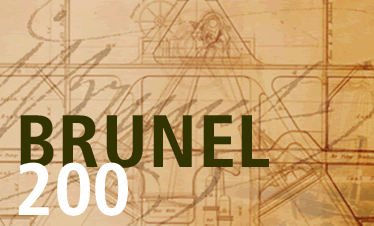
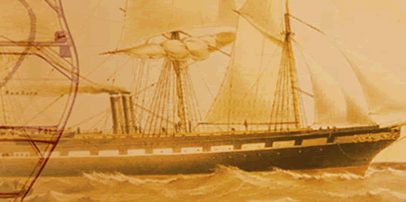
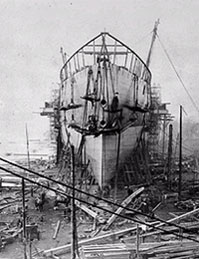
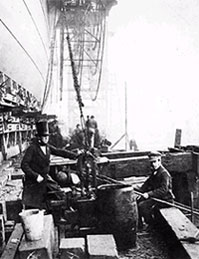
ss Great Eastern under construction
(ICE)
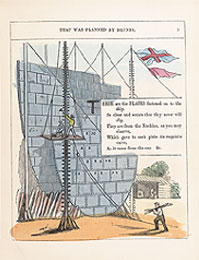
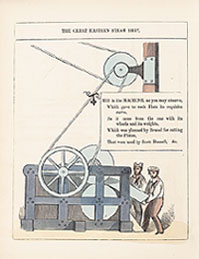
Pages from child’s promotional book on
ss Great Eastern (Private collection)
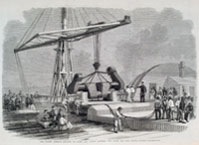
Hauling engine on board
(University of Bristol)
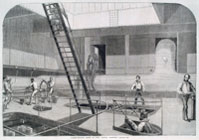
Screw-engine room
(University of Bristol)
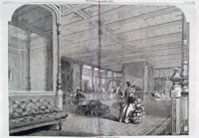
Grand salon (University of Bristol)
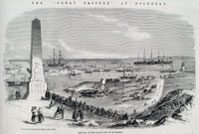
Arriving at Holyhead
(University of Bristol)
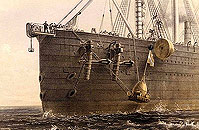
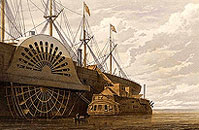
Illustrations of ss Great Eastern laying
the Atlantic Cable (ICE)






The ss Great Eastern was conceived as the biggest steamship yet to be built, one that would be capable of carrying 4,000 passengers at a time on a non-stop trip to Australia.
Brunel was partnered in the venture by John Scott Russell, who he had met during preparations for the Great Exhibition of 1851. Their proposal was offered to the Eastern Steam Navigation Company who were looking for new business interests. Brunel placed a number of his own nominees on the company board and contributed considerable personal sums to the capital needed. Scott Russell’s engineering firm was awarded the contract to construct the ship. Work began at Napier Yard in Millwall in 1853. Brunel wrote:
I never embarked on one thing to which I have so entirely devoted myself, and to which I have devoted so much time, thought and labour, on the success of which I have staked my reputation, and to which I have so largely committed myself and those who were disposed to place faith in me; nor was I ever engaged in a work which from its nature required for its conduct and success that it should be entrusted so entirely to my individual management and control...
The ship, originally called Leviathan, was to be nearly 700ft/213.36m long, six times the size of the largest ship built to date. Brunel designed her to be unsinkable, extending the watertight double plating to five ft/1.5m above the ship’s deepest load line. In addition, iron bulkheads divided the ship into ten watertight compartments. To move such a large ship required two engines, one attached to a screw propeller and built by James Watt & Co, the other used to drive two enormous paddle wheels, built by Scott Russell. The ship was constructed parallel to the riverbank with the intention of easing her sideways down specially constructed slipways and floating her off on high tide: her size meant a normal launch was impossible.
John Pudney has described the division of labour between the two partners as Scott Russell being in charge of the hardware and Brunel in charge of the paper. The relationship soon deteriorated. Things came to a head on 4 February 1856 when Scott Russell was declared bankrupt having kept the precariousness of his financial situation hidden from his partner. Work came to a halt and the accountants and bankers argued over the fate of the half-finished ship. With considerable effort, more money was raised and Brunel assumed full control of the project. However, he struggled to win over Scott Russell’s men, who proved uncooperative, progress was slow and there were endless contractual arguments.
Under threat of another bankruptcy should there be further delays, there was an attempt to launch the hull on 3 November 1857 using untried and inadequate equipment. Brunel had originally planned to use hydraulic launching gear specially built for the project but because of the financial difficulties this was judged by the company to be too expensive and he had to use steam winches and capstans worked by teams of men. To further complicate an already risky procedure, the company, seeking to make money, had sold tickets to the public to attend the launch event and the yard was overrun with onlookers, getting in the way of Brunel’s system of signals. The launch was a disaster and the attempt abandoned.
Brunel tried again on the 19th and 28th, but to little effect. The failure of the winch system led Brunel to turn to the use of hydraulic jacks to push the ship down the slope. These were not up to a job of this magnitude and after ten weeks of the ship inching painfully forward, Brunel stopped the work in mid-December until better equipment could be obtained. This was built by the Tangye brothers, based in Birmingham, who would later boast ‘we launched the Great Eastern and she launched us’.
With the new hydraulic rams in place and the loan of the hydraulic press used by Robert Stephenson for his Britannia Bridge project, progress improved in January, although bad weather caused further delays. At 1.42pm on 31 January 1858 the ship finally floated and was moved to Deptford for fitting out. A new company, the Great Ship Company, was formed in November 1858 to undertake completion of the work and the Eastern Steam Navigation Company was dissolved.
Sea trials were planned for 7 September 1859 but were postponed to the 9th (Brunel was bedridden having collapsed on deck four days before). In the haste to be ready, two temporary stop cocks fitted to the heaters on two of the ship’s funnels were left in place, causing a devastating explosion that killed five men and injured several others. News of the disaster is thought to have hastened Brunel’s death.
The ss Great Eastern proved uneconomic as a passenger ship but had a new lease of life when she was used to lay the first successful trans-Atlantic cable. Britain needed a fast communication link with the USA and the Telegraph Construction and Maintenance Company was formed in April 1864 to take up this challenge. Brunel’s friend and colleague, Daniel Gooch was one of the company’s directors. He formed a syndicate that purchased the Great Eastern, the only vessel capable of carrying the immense length of cable that was required, for £25,000. He then offered the ship to the company free of charge on the understanding that if the venture was successful the syndicate would receive £50,000 in Atlantic Telegraph stock.
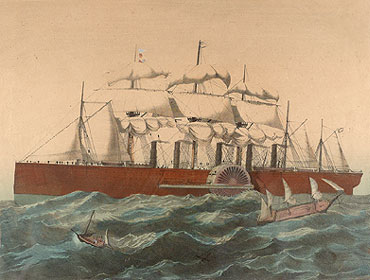
ss Great Eastern (Private collection)
The ship set out from Ireland in July 1865. On 2 August, 600 miles from Newfoundland, the cable end was lost overboard and the attempt abandoned. A new company was formed at the suggestion of Gooch – the Anglo-American Telegraph Company – and a fresh attempt with an improved cable began, reaching Newfoundland on July 27 1866. Gooch wrote in his diary:
We have achieved our great object and laid our cable from shore to shore, along which the lightning may now flash messages of peace and goodwill between two kindred nations. Is it wrong that I should have felt as though my heart would burst when that end of our long line touched the shore amid the booming of cannon, the wild half-mad cheers and shouts of men? It seemed more than I could bear.
John Gordon Steele, in his account of the cable laying wrote:
It is by no means the least of her ironies that the one thing the Great Eastern turned out to be good for – indeed perfect for – was perhaps the only use her creator had not foreseen from the beginning.
